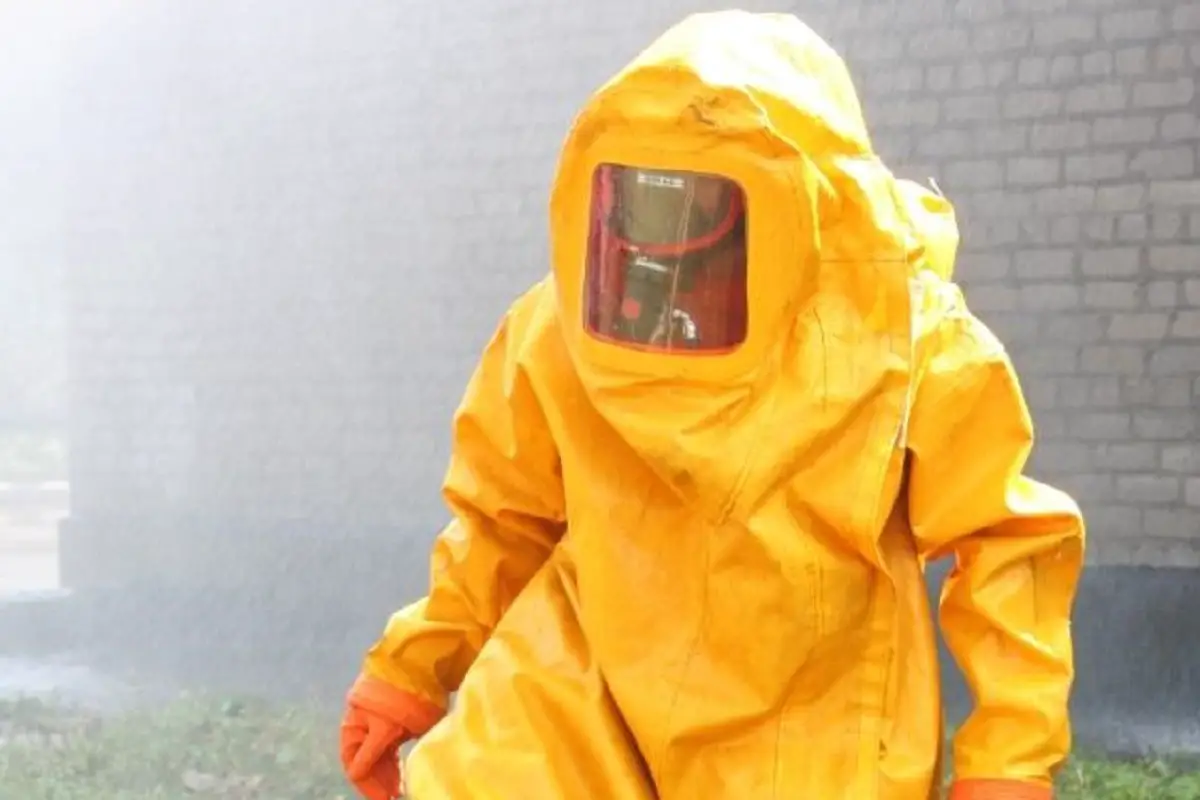Hazmat suits are a specialized form of PPE that protect the wearer from hazardous chemicals that can damage their health. But for them to be deamed effective, they must be tested by reputable industry agencies.
Hazmat Suit Testing Prior to Shipment
Before being shipped for sale to customers, hazmat suits must pass these tests, or face possible litigation from wearers who end up injured due to wearing a faulty suit.
Hazmat suit manufacturers use a special pressure test kit to check if there is any pressure loss to the suit which reveals any leaks. This test will inflate a level A hazmat suit to look like a balloon.
Manufacturers sometimes have differences in how they test their hazmat suits. The industry may also confusion over which level hazmat suit certification is required for manufacturers to meet. If unsure, contact the hazmat suit manufacturer and ask them which performance tests they complete prior to shipment.
Recommended Hazmat Suits
Medtecs Hazmat Suits – Fabric Passed AAMI Level 4 Disposable Coverall PPE
YIBER Disposable Protective Coverall Hazmat Suit, Heavy Duty Painters Coveralls, Made of SF Material
DuPont Tychem 2000 Hazmat Suit Disposable Coverall with Hood, Elastic Wrists & Ankles, Serged Seams
Testing Used For Hazmat Suits
Hazmat suits must pass certain tests to be deemed effective. These tests check for:
- Chemical permeation
- Gas tight integrity
- Puncture tear resistance
- Seam-breaking resistance
- Abrasion resistance
- Trepeziodal tear resistance
- Flame resistance
Chemical and gas permeation tests will check for resistance to specific lists of numerous chemicals, gases, and warfare agents.
The higher the level hazmat suits is (A, B, C, D), the more stringent the test requirements. A level A hazmat suit must pass the highest rated tests to be considered safe to wear. Not all hazmat suits must pass every test, which will depend on the tasks and work environments they are made for.

Each hazmat suit will be tested for all components required by the test. Users of hazmat suits should therefore not remove any components while wearing the suit, or the suit will lose its ability to protect the wearer from certain dangers.
Hazmat suit testing requirements are presented by the following organizations:
Occuaptional Safety And Health Administration
This standard covers definition of terms related to gas-tight safety suits, and the test methods of determining if the totally-encapsulated chemical protective suit is gas tight.
The test involves filling the suit with pressurized air for a period of three minutes to determine if the suits pressure drops by 20% over this time. If so, the suit is deemed not effective for service and should be removed.
Chemical hazmat suits must pass this test to comly with OSHA Standard 1926.65 – Hazardous waste operations and emergency response.
ASTM International
This test covers procedures for measuring the permeation resistance capability of chemical protective clothing.
This test covers procedures for measuring the integrity of the suit, including parts such as gloves, foot protection, visors, seams, and zippers. This test does not check for vapor protection capability, rather its ability to hold a steady pressure over time. It also does not test the exhaust valve of a hazmat suit.
National Fire Protection Association (NFPA)
The NFPA 1991 standard covers requirements for design, testing, and certification, among others, for vapor-protective suits used by emergency response workers in response to hazardous materials incidents or terrorist activities. This is the highest rated test the NFPA provides for hazmat suits. These certifications are required for any fire department, or local or state fire safety organization.
NFPA 1994 also tests for similar requirements, but is known for being less stringent that the NFPA 1991 standard.
European Standards (EN) And International Organization for Standardization (ISO)
This is a laboratory-based test that checks a hazmat suits materials for resistance to permeation by liquids or gaseous chemicals. This includes all parts of a hazmat, including gloves and footwear.
Other european standards for chemical protective clothing provide the following testing requirements:
- EN 13034+A1
- EN ISO 13982-1+A1
- EN 14605+A1
- EN ISO 1749-4 Low Level
- EN ISO 13982-2+A1
- EN ISO 1749-4 High Level
- EN ISO 17491-3
- EN ISO 6530
- EN 530
- EN ISO 7854
- EN ISO 9073-4
- EN ISO 13934-1
- EN 863
- EN ISO 13935-2
If you’re researching hazmat suits check out our detailed Hazmat Suits Buying Guide here >
To Close
This list of tests does not cover all that are required. There are others that help determine if a hazmat suit is fully waterproof or water-resistant and safe for use.
To learn about these, see our post Are Hazmat Suits Waterproof?
Hazmat suits are required to be capable of protecting the wearer from hazardous substances while perfroming their tasks. The only way to be sure of this is to have them tested in a standardized way. Make sure any hazmat suit you wear has passed the required chemical penetration tests and has certifications provided on the label or packaging.
UP NEXT: What Size HAZMAT Suit Do I Need?
